Technicolor MediaAccess TG799vn v2 Setup Guide
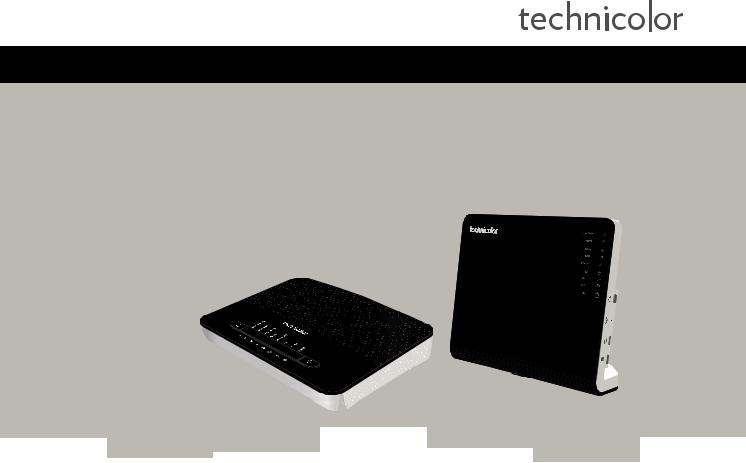
SETUP AND USER GUIDE
MediaAccess TG799vn v2
SETUP AND USER GUIDE
MediaAccess TG799vn v2
Copyright
Copyright ©1999-2013 Technicolor. All rights reserved.
Distribution and copying of this document, use and communication of its contents is not permitted without written authorization from Technicolor. The content of this document is furnished for informational use only, may be subject to change without notice, and should not be construed as a commitment by Technicolor. Technicolor assumes no responsibility or liability for any errors or inaccuracies that may appear in this document.
TECHNICOLOR WORLDWIDE HEADQUARTERS 1, rue Jeanne d’Arc
92443 Issy-les-Moulineaux France
http://www.technicolor.com
Trademarks
The following trademarks may be used in this document:
AutoWAN sensing™ is a trademark of Technicolor.
Adobe®, the Adobe logo, Acrobat and Acrobat Reader are trademarks or registered trademarks of Adobe Systems, Incorporated, registered in the United States and/or other countries.
Apple® and Mac OS® are registered trademarks of Apple Computer, Incorporated, registered in the United States and other countries.
Bluetooth® word mark and logos are owned by the Bluetooth SIG, Inc.
DECT™ is a trademark of ETSI.
DLNA® is a registered trademark, DLNA disc logo is a servicerk,mand DLNA Certified is a trademark of the Digital Living Netw ork Alliance. Digital Living Network Alliance is a service mark of the Digital Living Network Alliance.
Ethernet™ is a trademark of Xerox Corporation.
Microsoft®, MS-DOS®, Windows®, Windows NT® and Windows Vista® are either registered trademarks or trademarks of Microsoft Corporation in the United States and/or other countries.
UNIX® is a registered trademark of UNIX System Laboratories, Incorporated.
UPnP™ is a certification mark of the UPnP™ Implementers Corporation.
Wi-Fi®, WMM® and the Wi-Fi logo are registered trademarks of the Wi-Fi Alliance®. Wi-Fi CERTIFIED, Wi-Fi ZONE, Wi-Fi Protected Access, Wi-Fi Multimedia, Wi-Fi Protected Setup, WPA, WPA2 and their respective logos are trademarks of the Wi-Fi Alliance®.
Other brands and product names may be trademarks or registered trademarks of their respective holders. All other logos, tradema rks and service marks are the property of their respective owners, where marked or not.
Document Information
Status: v2.0 (June 2013)
Reference: DMS-CTC-20110713-0016
Short Title: Setup and User Guide MediaAccess TG799vn v2 R10.2.x

CONTENTS
1 |
Getting Started ......................................................................................................... |
3 |
||
|
1.1 |
Features at a Glance ........................................................................................................................ |
4 |
|
|
1.2 |
User Scenarios ............................................................................................................................................ |
5 |
|
|
1.3 |
Components .............................................................................................................................................. |
6 |
|
|
|
1.3.1 |
Power ................................................................................................................................................................................ |
7 |
|
|
1.3.2 |
Local Network Connection........................................................................................................................................... |
8 |
|
|
1.3.3 |
Broadband Connection ................................................................................................................................................. |
9 |
|
|
1.3.4 |
Voice Connection ........................................................................................................................................................ |
10 |
|
|
1.3.5 |
Buttons............................................................................................................................................................................ |
11 |
|
|
1.3.6 |
Status LEDs ................................................................................................................................................................... |
12 |
|
1.4 |
Preparing for the Installation............................................................................................................ |
15 |
|
2 |
Guided Installation................................................................................................... |
17 |
||
3 |
Manual Installation................................................................................................... |
21 |
||
|
3.1 |
Connecting the MediaAccess Gateway to your Service Provider’s Network .................................. |
22 |
|
|
|
3.1.1 |
Setting up your MediaAccess Gateway as DSL Gateway....................................................................................... |
23 |
|
|
3.1.2 |
Setting up your MediaAccess Gateway as Local Router ........................................................................................ |
26 |
|
3.2 |
Powering on the MediaAccess Gateway .............................................................................................. |
27 |
|
|
3.3 |
Connecting Your Network Devices to the MediaAccess Gateway ................................................. |
28 |
|
|
|
3.3.1 Setting up a Wireless Connection.............................................................................................................................. |
29 |
|
|
|
3.3.2 Setting up a Wired Connection.................................................................................................................................. |
30 |
|
|
3.4 |
Configure the MediaAccess Gateway ........................................................................................... |
....... 31 |
|
|
3.5 |
Setting Up the 3G Fall-Back WAN Connection.................................................................................. |
32 |
|
|
|
3.5.1 Managing your Mobile Connection with the MediaAccess Gateway GUI........................................................... |
33 |
|
|
|
3.5.2 Inserting a Mobile USB Adapter ................................................................................................................................ |
34 |
|
4 |
Configuration Tools................................................................................................. |
35 |
||
|
4.1 |
MediaAccess Gateway GUI ................................................................................................................... |
36 |
|
|
|
4.1.1 |
Access............................................................................................................................................................................. |
37 |
|
|
4.1.2 |
Components ................................................................................................................................................................. |
38 |
|
|
4.1.3 Protecting Access to the MediaAccess Gateway .................................................................................................... |
40 |
|
|
4.2 |
Backing Up/Restoring your Configuration ........................................................................................... |
41 |
|
|
4.3 |
Access From the Internet....................................................................................................................... |
42 |
|
5 The MediaAccess Gateway Wireless Access Point ............................................... |
43 |
|||
|
5.1 |
Connecting Your Wireless Client via WPS ......................................................................................... |
44 |
|
|
5.2 |
Connecting Your Wireless Client without WPS ................................................................................. |
46 |
|
|
5.3 |
Connecting Your Wireless Client via QR Code................................................................................. |
47 |
|
|
5.4 Securing Your Wireless Connection..................................................................................................... |
48 |
||
6 |
Telephony................................................................................................................. |
51 |
||
DMS-CTC-20110713-0016 v2.0
i

CONTENTS
|
6.1 |
Setting Up Your Telephone Network ................................................................................................... |
52 |
|
|
|
6.1.1 Connecting a DECT Phone to Your MediaAccess Gateway ............................................................................... |
53 |
|
|
|
6.1.2 Connection to the Traditional Telephone Network................................................................................................ |
54 |
|
|
|
6.1.3 Configuring the MediaAccess Gateway VoIP Service ........................................................................................... |
55 |
|
|
6.2 |
Address Book............................................................................................................................................ |
57 |
|
|
6.3 |
Telephony Services................................................................................................................................. |
59 |
|
|
|
6.3.1 |
Activating a Telephony Service on your MediaAccess Gateway .......................................................................... |
60 |
|
|
6.3.2 |
Common Telephony Services ..................................................................................................................................... |
61 |
|
6.4 |
Viewing Call Logs ................................................................................................................................... |
64 |
|
7 |
Saving Energy ......................................................................................................... |
65 |
||
|
7.1 |
Code of Conduct.................................................................................................................................... |
66 |
|
|
7.2 |
ECO Manager.......................................................................................................................................... |
67 |
|
8 |
Sharing Content...................................................................................................... |
69 |
||
|
8.1 |
The Network File Server ......................................................................................................................... |
71 |
|
|
8.2 |
The UPnP AV Media Server ................................................................................................................. |
74 |
|
|
|
8.2.1 Configuring the UPnP AV Media Server ................................................................................................................. |
75 |
|
|
|
8.2.2 Using the UPnP AV Media Server ............................................................................................................................ |
76 |
|
|
8.3 |
The FTP Server ........................................................................................................................................ |
78 |
|
|
8.4 |
Managing your Shared Content............................................................................................................ |
80 |
|
|
8.5 |
Safely Removing your USB Storage Device........................................................................................ |
82 |
|
9 |
Network Services .................................................................................................... |
83 |
||
|
9.1 |
UPnP |
......................................................................................................................................................... |
84 |
|
|
9.1.1 Accessing Your MediaAccess Gateway via UPnP .................................................................................................. |
85 |
|
|
|
9.1.2 Managing your Internet connection via UPnP ......................................................................................................... |
86 |
|
|
|
9.1.3 ..................................................................................................Configuring UPnP on the MediaAccess Gateway |
88 |
|
|
|
9.1.4 ................................................................................................................................Installing UPnP on Windows XP |
89 |
|
|
9.2 |
Assigning ...........................................................................a service (HTTP, FTP,...) to a Computer |
91 |
|
|
9.3 |
Dynamic ..........................................................................................................................................DNS |
93 |
|
|
9.4 |
Network ..............................................................................................................................Time Server |
94 |
|
10 Internet ......................................................................................................Security |
97 |
|||
|
10.1 Parental ......................................................................................................................................Control |
98 |
||
|
|
10.1.1 ...................................................................................................................... |
Configuring Content - based Filtering |
100 |
|
|
10.1.2 ............................................................................................................... |
Adding Rules for Address - Based Filtering |
101 |
|
10.2 Firewall .................................................................................................................................................... |
103 |
||
|
10.3 Access .......................................................................................................................................Control |
105 |
||
|
10.4 Wireless ..........................................................................................................................Time Control |
107 |
||
11 |
Support.................................................................................. |
|
.................................109 |
|
|
11.1 |
Setup ..........................................................................................................................Troubleshooting |
110 |
|
|
11.2 |
General ..............................................................................MediaAccess Gateway Troubleshooting |
1 11 |
|
DMS-CTC-20110713-0016 v2.0
ii

CONTENTS
11.3 |
Wired Connection Troubleshooting .................................................................................................... |
112 |
11.4 |
Wireless Connection Troubleshooting................................................................................................. |
113 |
11.5 Voice over IP Troubleshooting ............................................................................................................ |
114 |
|
11.6 |
Content Sharing Troubleshooting ....................................................................................................... |
115 |
11.7 |
Reset to Factory Defaults ..................................................................................................................... |
116 |
DMS-CTC-20110713-0016 v2.0
iii

CONTENTS
iv
DMS-CTC-20110713-0016 v2.0
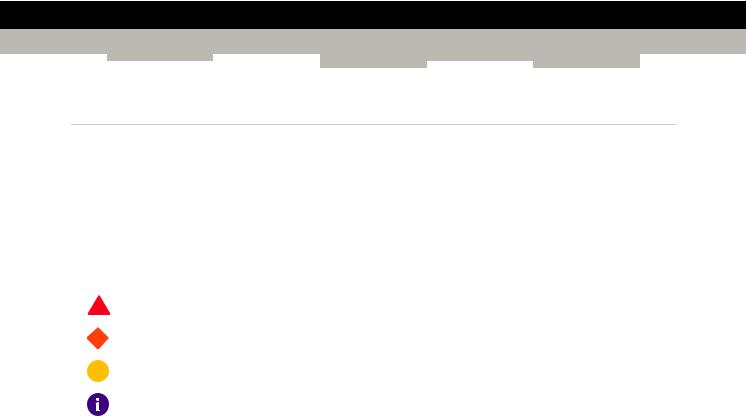
ABOUT THIS SETUP AND USER GUIDE
About this Setup and User Guide
In this Setup and User Guide
The goal of this Setup and User Guide is to show you:
Set up your MediaAccess Gateway and local network
Configure and use the main features of your MediaAccess Gateway.
For more advanced scenarios and features visit the documentation pages on www.technicolor.com.
Used Symbols
The danger symbol indicates that there may be a possibility of physical injury.
The warning symbol indicates that there may be a possibility of equipment damage.
The caution symbol indicates that there may be a possibility of service interruption.
The note symbol indicates that the text provides additional information about a topic.
Terminology
Generally, the MediaAccess TG799vn v2 will be referred to as MediaAccess Gateway in this Setup and User Guide.
Typographical Conventions
Following typographical convention is used throughout this manual:
This sample text indicates a hyperlink to a Web site.
Example: For more information, visit us at www.technicolor.com.
This sample text indicates an internal link.
Example: If you want to know more about guide, see “About this Setup and User Guide” on page 1.
This sample text indicates an important content-related word.
Example: To enter the network, youmust authenticate yourself.
This sample text indicates a GUI element (commands on menus and buttons, dialog box elements, file names, paths and folders).
Example: On the File menu, click Opento open a file.
DMS-CTC-20110713-0016 v2.0
1

ABOUT THIS SETUP AND USER GUIDE
DMS-CTC-20110713-0016 v2.0
2

1 GETTING STARTED
1 Getting Started
Introduction
This chapter gives you a brief overview of the main features and components of the MediaAccess Gateway. After this chapter we will start with the installation.
Do not connect any cables to the MediaAccess Gateway until instructed to do so.
DMS-CTC-20110713-0016 v2.0
3

1 GETTING STARTED
1.1 Features at a Glance
Introduction
This section provides a brief overview of the main features of your MediaAccess Gateway.
IPv6 Ready
Your MediaAccess Gateway is IPv6 ready. Internet Protocol version 6 (IPv6) is the next generation of Internet technologies aiming to effectively support the ever-expanding Internet usage and functionality, and also to address security concerns that exist in an IPv4 environment.
Internet connection features
Broadband Internet access via the integrated DSL modem.
The first chapters describe how to connect your MediaAccess Gateway to the Internet.
Broadband Internet access via the Gigabit WAN port.
The first chapters describe how to connect your MediaAccess Gateway to the Internet.
3G (Fall-back) High-speed Internet Access via the optional mobile USB adaptor.
For more information, see“3.5 Setting Up the 3G Fall-Back WAN Connection” on page 32 .
Internet Security for your entire network.
For more information, see“10 Internet Security” on page 97 .
Useful network tools like UPnP, Dynamic DNS and many more. For more information, see“9 Network Services” on page 83 .
Local networking features
Wired access for your local network devices via the Ethernet interface.
For more information, see“3.3 Connecting Your Network Devices to the MediaAccess Gateway” on page 28 .
Wireless access for your local network devices via the integrated IEEE 802.11n wireless access point. For more information, see“5 The MediaAccess Gateway Wireless Access Point” on page 43 .
An Integrated Media Server allowing you to share your media with media players and other network devices. For more information, see “8 Sharing Content” on page 69.
Telephony features
The MediaAccess Gateway offers Voice over IP (VoIP) connectivity for traditional phones, DECT phones and IP phones. For more information see “6 Telephony” on page 51
ECO label
Technicolor’s ECO label guarantees you that the MediaAccess Gateway is able to reduce its power consumption to an absolute minimum. For more information, see “7 Saving Energy” on page 65.
MediaAccess Gateway configuration tools
The MediaAccess Gateway Setup CD allows you to configure your MediaAccess Gateway and helps you to connect your computers to the MediaAccess Gateway.
The MediaAccess Gateway GUI allows you to configure your MediaAccess Gateway via your web browser. For more information, see“4.1 MediaAccess Gateway GUI” on page .36
DMS-CTC-20110713-0016 v2.0
4
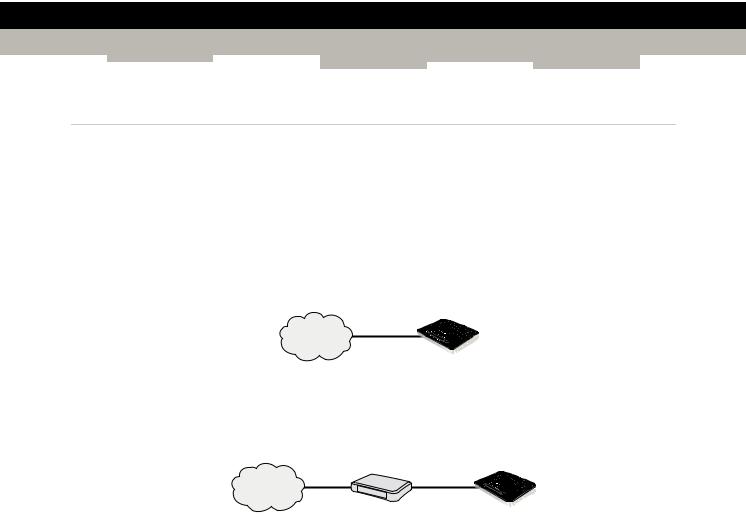
1 GETTING STARTED
1.2 User Scenarios
Scenarios
Depending of the architecture of your home network, you can use the MediaAccess Gateway in either of the following scenarios:
DSL Gateway
Local Router
DSL Gateway
The MediaAccess Gateway is connected to the DSL network of your service provider and brings the Internet to your home.
Internet
MediaAcces Gateway
Local Router
The MediaAccess Gateway is placed behind another gateway or modem. In this setup the gateway or modem in front of the MediaAccess Gateway will establish the connection to the Internet:
Internet
Modem/Router |
MediaAcces Gateway |
This scenario is used when:
The Internet connectivity is provided by another device (for example, a cable modem). The MediaAccess Gateway is used to add specific services to your home network.
Your service provider is using Ethernet in the First Mile (EFM). The Ethernet signal is directly coming into your home.
Your service provider is using Ethernet To The Home (ETTH).
MediaAccess Gateway is directly connected to the terminator of your service provider’s fiber-optic network and your local network
DMS-CTC-20110713-0016 v2.0
5

1 GETTING STARTED
1.3 Components
Overview
This section provides an overview of the different components of the MediaAccess Gateway:
Topic |
Page |
|
|
1.3.1 Power |
7 |
|
|
1.3.2 Local Network Connection |
8 |
|
|
1.3.3 Broadband Connection |
9 |
|
|
1.3.4 Voice Connection |
10 |
|
|
1.3.5 Buttons |
11 |
|
|
1.3.6 Status LEDs |
12 |
|
|
DMS-CTC-20110713-0016 v2.0
6

1 GETTING STARTED
1.3.1 Power
Overview
Power inlet
The power inlet (


 ) allows you to connect the power supply.
) allows you to connect the power supply.
Only use the power supply delivered with your MediaAccess Gateway.
Power switch
The power switch ( ) allows you to power on/off your MediaAccess Gateway.
) allows you to power on/off your MediaAccess Gateway.
DMS-CTC-20110713-0016 v2.0
7
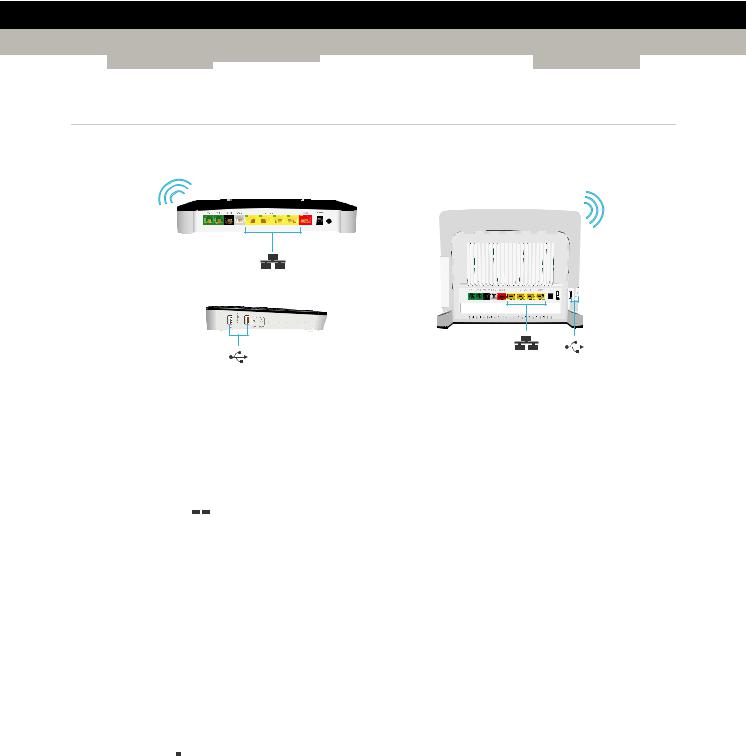
1 GETTING STARTED
1.3.2 Local Network Connection
Overview
Wireless Access Point
The built-in WiFi-certified wireless access point provides wireless access to your WiFi-certified wireless clients.
For more information, see “5 The MediaAccess Gateway Wireless Access Point” on page 43.
Ethernet switch
The Ethernet switch ( ) allows you to connect an Ethernet device (for example, a computer) to your local network. For more information, see “3.3 Connecting Your Network Devices to the MediaAccess Gateway” on page 28.
) allows you to connect an Ethernet device (for example, a computer) to your local network. For more information, see “3.3 Connecting Your Network Devices to the MediaAccess Gateway” on page 28.
All Ethernet ports on the MediaAccess Gateway are Gigabit Ethernet ports and have a maximum speed of 1 Gbps (Gigabit per second).
A LED may be provided per Ethernet port to indicate link integrity (or activity).
LED Status |
Description |
|
|
Solid on |
Device connected. |
|
|
Blinking |
Device connected and sending/receiving data. |
|
|
Off |
No device connected. |
|
|
USB Port
The USB port (

 ) can be used to:
) can be used to:
Connect a USB mass storage device to share your content (for example, music, movies,...):
On your local network via the Network File server or the UPnP AV Media Server.
On Internet via FTP.
For more information, see“8 Sharing Content” on page 69 .
Connect a 3G mobile adaptor to set up a 3G connection that can work as a backup for your main Internet connection. For more information, see“3.5 Setting Up the 3G Fall-Back WAN Connection” on page 32 .
DMS-CTC-20110713-0016 v2.0
8
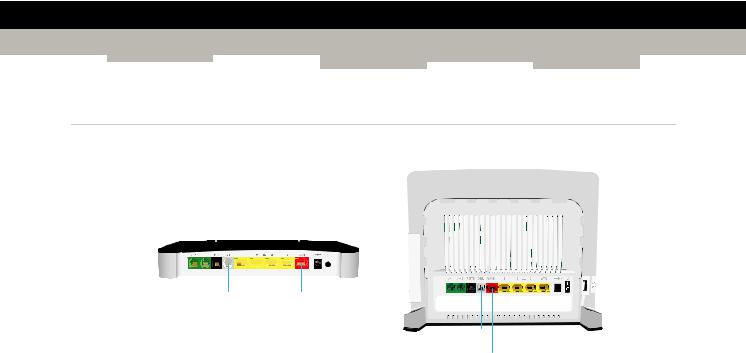
1 GETTING STARTED
1.3.3 Broadband Connection
Overview
DSL WAN
DSL
WAN
DSL port
This port can be used to connect your MediaAccess Gateway to your service provider’s DSL network.
For more information, see “3.1 Connecting the MediaAccess Gateway to your Service Provider’s Network” on page 22.
WAN port
This port allows you to use your MediaAccess Gateway as Local Router. For more information, see “1.2 User Scenarios” on page 5.
DMS-CTC-20110713-0016 v2.0
9
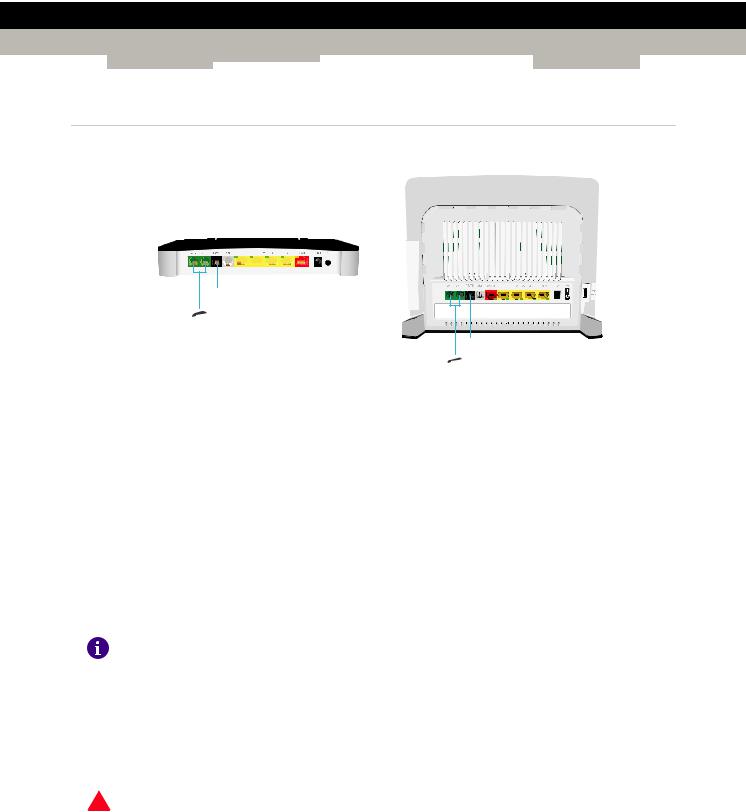
1 GETTING STARTED
1.3.4 Voice Connection
Overview
PSTN
Phone
PSTN
Phone
DECT base station
The integrated DECT base station allows you to connect your DECT phones to the MediaAccess Gateway. This way you will be able to make phone calls over the Internet and save on communication costs, especially for long-distance calls.
Phone Port
The Phone ( ) port allows you to connect a traditional phone to your MediaAccess Gateway. This way you will be able to make phone calls over the Internet and save on communication costs, especiallyfor long-distance calls.
) port allows you to connect a traditional phone to your MediaAccess Gateway. This way you will be able to make phone calls over the Internet and save on communication costs, especiallyfor long-distance calls.
For more information, see “6.1 Setting Up Your Telephone Network” on page.52
PSTN Port (optional)
The PSTN port allows you to connect the MediaAccess Gateway to the traditional telephone network, i.e. the Public Switched Telephone Network (PSTN). When the VoIP connection is not available, the MediaAccess Gateway will automatically switch from VoIP to the traditional telephone network.
If your MediaAccess Gateway does not have a PSTN port, this means that:
Your MediaAccess Gateways has an integrated filter
The MediaAccess Gateway separates the phone signal from the signal coming from the DSL port. Your MediaAccess Gateway has an integrated filter if the product name printed on the label of your MediaAccess Gateway ends with “wIF” (with Integrated Filter). If this suffix is not present, then your MediaAccess Gateway does not have an integrated filter.
- or -
Your MediaAccess Gateway is VoIP-only
All calls passing throug the MediaAccess Gateway will be done via VoIP.
Be aware that, if you are not connected to the traditional telephone network, emergency calls will not be possible when your Internet connection is down or your MediaAccess Gateway is powered off.
For more information, see “6.1.2 Connection to the Traditional Telephone Network” on page 54.
DMS-CTC-20110713-0016 v2.0
10
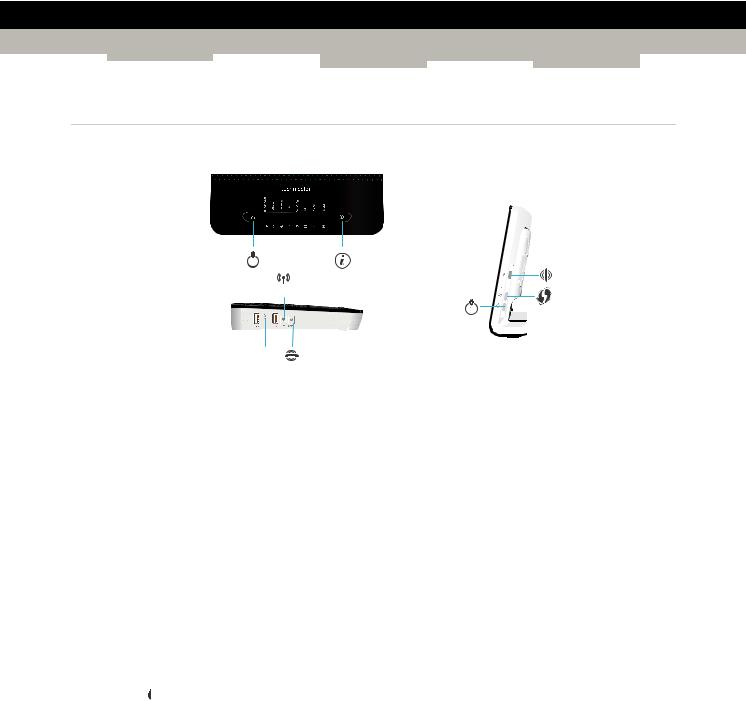
1 GETTING STARTED
1.3.5 Buttons
Overview
Reset 

WPS
Reset
DECT
Info  button
button
The Info ( ) button allows you to enable the status LEDs. For more information, see “1.3.6 Status LEDs” on page 12.
) button allows you to enable the status LEDs. For more information, see “1.3.6 Status LEDs” on page 12.
DECT Pairing/Paging button
If you press the DECT pairing/paging  button:
button:
Between 1 and 5 seconds, the MediaAccess Gateway pages all connected DECT phones.
Longer than 5 seconds, switches to registration mode to allow you to connect your DECT phone(s) to the integrated DECT base station of the MediaAccess Gateway.
For more information, see“6.1.1 Connecting a DECT Phone to Your MediaAccess Gateway” on page 53 .
WPS button
The WPS (  ) button allows you to add new wireless clients to your network in a swift and easy way, without the need to enter any of your wireless settings manually.
) button allows you to add new wireless clients to your network in a swift and easy way, without the need to enter any of your wireless settings manually.
For more information, see “5.1 Connecting Your Wireless Client via WPS” on page 44.
ECO button
The ECO ( ) button allows you to disable your wireless access point. You can do this when you are not using the wireless access point. This allows you to save the energy that the MediaAccess Gateway would be using for the wireless access point. For more information, see “ECO button” on page 67.
) button allows you to disable your wireless access point. You can do this when you are not using the wireless access point. This allows you to save the energy that the MediaAccess Gateway would be using for the wireless access point. For more information, see “ECO button” on page 67.
The LED on the ECO button summarizes the overall status of your MediaAccess Gateway. For more information, see
“ECO LED” on page 12.
Reset button
The Reset button allows you to reset your MediaAccess Gateway to factory defaults.
For more information, see “11.7 Reset to Factory Defaults” on page 116.
DMS-CTC-20110713-0016 v2.0
11
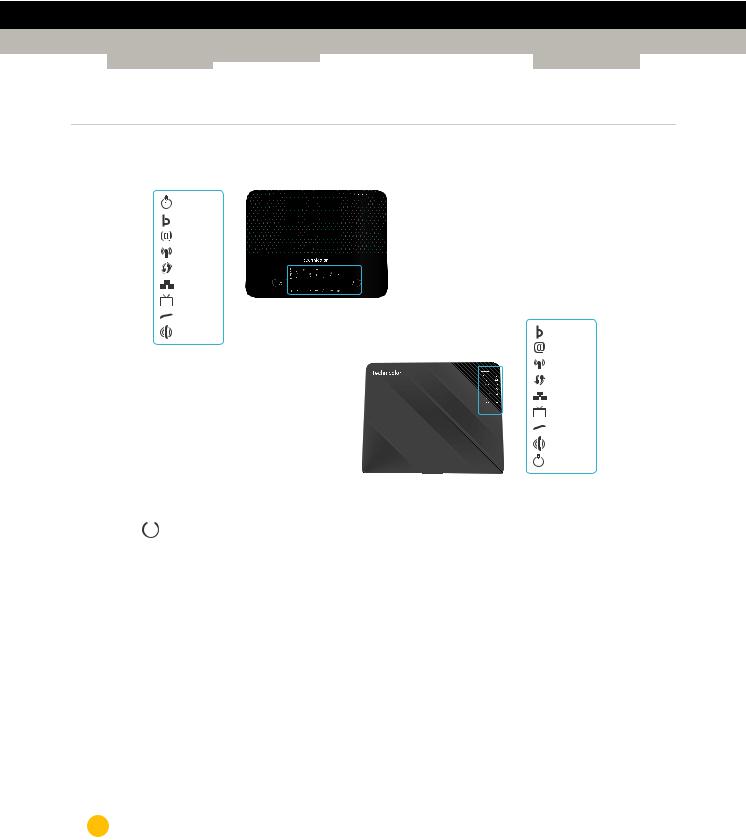
1 GETTING STARTED
1.3.6 Status LEDs
Introduction
On the top panel of your MediaAccess Gateway, you can find a number of status LEDs, indicating the state of the device.
ECO
Broadband
Internet
Wireless
WPS
Ethernet
TV
Voice
DECT |
Broadband |
Internet
Wireless
WPS
Ethernet
TV
Voice
DECT
ECO
ECO LED
The ECO (  ) LED provides information about the overall state of your MediaAccess Gateway. For more information, see “ECO button” on page 11.
) LED provides information about the overall state of your MediaAccess Gateway. For more information, see “ECO button” on page 11.
Colour |
State |
Description |
|
|
|
Green |
Solid on |
All services are available. The wireless access point is enabled. The other |
|
|
status LEDs are deactivated. |
|
|
|
Blue |
Solid on |
All services are available. The wireless access point is disabled. The other |
|
|
status LEDs are deactivated. |
|
|
|
Red |
Solid on |
Some services are not available. The MediaAccess Gateway automatically |
|
|
activates the other status LEDs to allow you to see which services are |
|
|
running. |
|
|
|
Orange |
Solid on |
Bootloader selftest |
|
|
|
|
Blinking |
Bootloader active (during upgrade) |
|
|
|
Off |
|
The MediaAccess Gateway is powered off. |
|
|
|
The other status LEDs are only activated when the Internet service is down.
DMS-CTC-20110713-0016 v2.0
12

1 GETTING STARTED
Manually activating the status LEDs
If the ECO( ) button is green or blue, you first have to press the info(
) button is green or blue, you first have to press the info(  ) button to be able to view the status of the other LEDs.
) button to be able to view the status of the other LEDs.
For more information, see “Info button” on page 11.
Ethernet LED
Colour |
State |
Description |
|
|
|
Green |
Solid on |
Network device connected to the Ethernet switch. |
|
|
|
|
Blinking |
Network device connected to the Ethernet switch and sending/receiving |
|
|
data. |
|
|
|
Off |
|
No Ethernet connection on your local network or the status LEDs are |
|
|
deactivated |
|
|
|
Wireless LED
Colour |
State |
Description |
|
|
|
Green |
Solid on |
Wireless clients connected, no wireless activity |
|
|
|
|
Blinking |
Wireless clients connected, wireless activity |
|
|
|
Off |
|
No wireless clients connected or wireless access point disabled or the |
|
|
status LEDs are deactivated |
|
|
|
Broadband LED (if you are using the DSL Gateway scenario)
Colour |
State |
Description |
|
|
|
Green |
Solid on |
DSL line synchronised |
|
|
|
|
Blinking |
Trying to detect carrier signal or pending DSL line synchronisation |
|
|
|
Off |
|
MediaAccess Gateway powered offtheorstatus LEDs are deactivated. |
|
|
|
DMS-CTC-20110713-0016 v2.0
13

1 GETTING STARTED
Broadband LED (if you are using the Local Router scenario)
Colour |
State |
Description |
|
|
|
Green |
Solid on |
Connected to the WAN device |
|
|
|
Off |
|
Not connected to the WAN device or the status LEDs are deactivated |
|
|
|
Internet LED
Colour |
State |
Description |
|
|
|
Green |
Solid on |
Connected to the Internet, no activity |
|
|
|
|
Blinking |
Connected to the Internet, sending/receiving data |
|
|
|
Red |
Solid on |
Failed to setup the Internet connection |
|
|
|
Off |
|
No Internet connection or the status LEDs are deactivated |
|
|
|
Phone LED
Colour |
State |
Description |
|
|
|
Green |
Solid on |
Registered at your VoIP provider, no activity. |
|
|
|
|
Blinking |
Registered at your VoIP provider, activity. |
|
|
|
Off |
|
Not registered to your VoIP provider or the status LEDs are deactivated. |
|
|
|
DECT LED
Colour |
State |
Description |
|
|
|
Green |
Solid on |
DECT service up |
|
|
|
|
Blinking |
DECT activity or registering DECT clients |
|
|
|
Off |
|
DECT service down or the status LEDs are deactivated |
|
|
|
WPS LED
Colour |
State |
Description |
|
|
|
Green |
Solid On |
Client successfully registered via WPS |
|
|
|
Orange |
Blinking |
WPS registration ongoing |
|
|
|
Red |
Blinking |
Error occurred |
|
|
|
For more information about WPS, see “5.1 Connecting Your Wireless Client via WPS” on page.44
DMS-CTC-20110713-0016 v2.0
14

1 GETTING STARTED
1.4 Preparing for the Installation
DSL service requirements
This section is only applicable if you are using your MediaAccess Gateway as DSL gateway. For more information, see
“1.2 User Scenarios” on page 5.
Make sure that:
Your service provider activated the DSL service on your telephone line by your service provider.
You have the installation information (for example, user name, password, service profile,...) provided by your service provider at hand.
Local connection requirements
Wireless connection
If you want to connect your computer using a wireless connection, your computer must be equipped with a WiFi-certified wireless client adapter.
Wired connection
If you want to connect a computer using a wired connection, your computer must be equipped with an Ethernet Network Interface Card (NIC).
Start with the installation
You are now ready to start with the installation of your MediaAccess Gateway.
DMS-CTC-20110713-0016 v2.0
15

1 GETTING STARTED
DMS-CTC-20110713-0016 v2.0
16

2 GUIDED INSTALLATION
2 Guided Installation
Introduction
In the guided installation, the Setup wizard on the Setup CD will assist you with the installation of your MediaAccess Gateway.
If you do not want to use the Setup CD or if the Setup CD is not included in your package, follow the installation procedure described in “3 Manual Installation” on page 21.
Requirements
To use the guided installation you must comply with the following requirements:
Your computer must run one of the following operating systems:
Microsoft Windows 7 and higher
Microsoft Windows 7 x64 and higher
Microsoft Windows Vista and higher
Microsoft Windows XP Service Pack 2 (SP2) and higher
Mac OS X 10.6 (Snow Leopard)
Mac OS X 10.5 (Leopard)
Mac OS X 10.4 (Tiger)
You must have administrative rights on your computer.
If you do not comply with these requirements, use the “3 Manual Installation” on page 21.
Running the Setup wizard
To start the Setup wizard:
1 Insert the Setup CD into your computer's CDor DVD drive.
2If your computer runs:
Microsoft Windows: The Setup CD starts automatically.
If the Setup CD does not autostart, see “The Setup CD does not start automatically” on page 110.
Mac OS X: Double-click Menu in the window with the content of the Setup CD.
3 Select the language of your choice and clickOK .
4 The Setup wizard will now guide you through the installation of your MediaAccess Gateway.
DMS-CTC-20110713-0016 v2.0
17
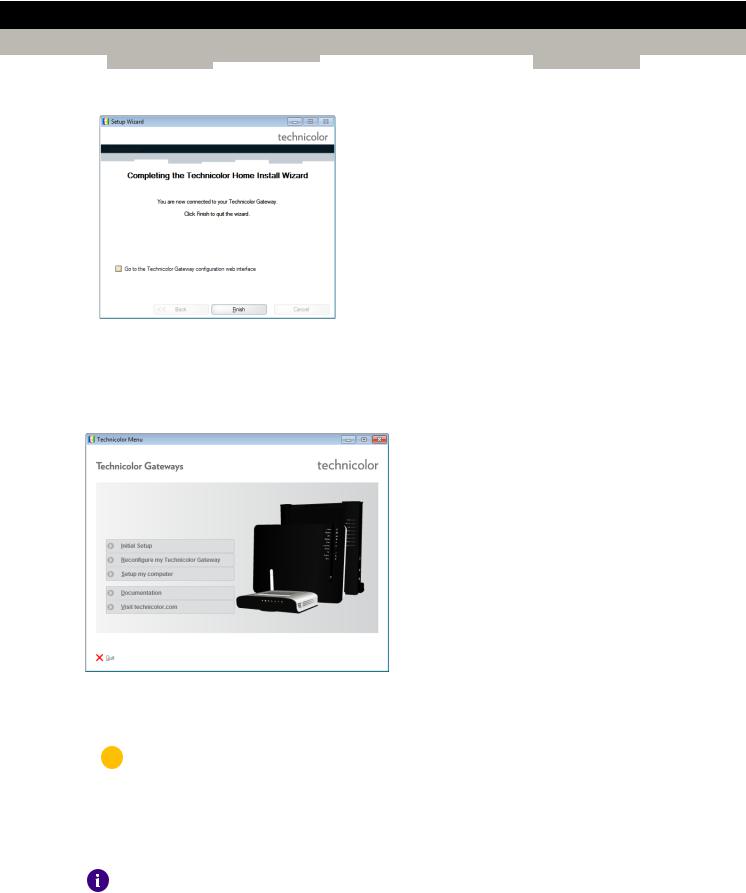
2 GUIDED INSTALLATION
5 At the end of the installation, the following screen appears:
Select Go to the MediaAccess Gateway web interface if you want to go to the MediaAccess Gateway GUI after closing the wizard. On the MediaAccess Gateway GUI, you can configure all services of your MediaAccess Gateway.
6 Click Finish.
7 The CD menu appears.
CD Menu
On the CD Menu, you can click:
Initial Setup to connect your computer to the MediaAccess Gateway and configure your local network.
Reconfigure my MediaAccess Gateway to fully reconfigure your MediaAccess Gateway.
If you reconfigure your MediaAccess Gateway via the CD menu, the MediaAccess Gateway will be reconfigured from scratch. All your current settings will be lost. If you only want to make small changes to your configuration (for example, changing the security), we recommended you to do this via the MediaAccess Gateway GUI. For more information, see “4.1 MediaAccess Gateway GUI” on page 36.
Setup my computer to connect your computer to the MediaAccess Gateway network.
Documentation to view a list of the documentation that is available for your MediaAccess Gateway.
Visit technicolor.com to visit the online support sections.
Actual available items depend on the Setup CD delivered with your MediaAccess Gateway.
DMS-CTC-20110713-0016 v2.0
18

2 GUIDED INSTALLATION
In case of problems
If you encounter problems during this installation please refer to “11.1 Setup Troubleshooting” on page 110.
Backup your configuration
Once you successfully installed your MediaAccess Gateway, it is recommend to backup your configuration. This will allows you to return to this configuration when needed (for example, after misconfiguration).
For more information, see “4.2 Backing Up/Restoring your Configuration” on page 41
DMS-CTC-20110713-0016 v2.0
19

2 GUIDED INSTALLATION
DMS-CTC-20110713-0016 v2.0
20

3 MANUAL INSTALLATION
3 Manual Installation
Installation
This chapter will help you to manually install your MediaAccess Gateway.
Setting up your network
Proceed as follows:
1Connect your MediaAccess Gateway to your service provider’s network.
For more information, see“3.1 Connecting the MediaAccess Gateway to your Service Provider’s Network” on page 22 .
2Power on the MediaAccess Gateway.
For more information, see“3.2 Powering on the MediaAccess Gateway” on page. 27
3Connect your computer to the MediaAccess Gateway.
For more information, see“3.3 Connecting Your Network Devices to the MediaAccess Gateway” on page 28 .
4Configure your MediaAccess Gateway.
For more information, see“3.4 Configure the MediaAccess Gateway” on page 31 .
5Connect your (DECT) phones.
For more information, see“6 Telephony” on page 51 .
6 Share your content or media on your local network, continue with “8 Sharing Content” on page 69.
7If you purchased the mobile USB adapter, setup the 3G backup connection.
For more information, see“3.5 Setting Up the 3G Fall-Back WAN Connection” on page 32 .
8Once you successfully installed your MediaAccess Gateway, it is recommend to backup your configuration. This will allows you to return to this configuration when needed (for example, after misconfiguration). For more information, see
“4.2 Backing Up/Restoring your Configuration” on page 41.
DMS-CTC-20110713-0016 v2.0
21

3 MANUAL INSTALLATION
3.1Connecting the MediaAccess Gateway to your Service Provider’s Network
Identifying your setup
If you are using the MediaAccess Gateway as:
DSL Gateway, continue with “3.1.1 Setting up your MediaAccess Gateway as DSL Gateway” on page 23.
Local Router, continue with “3.1.2 Setting up your MediaAccess Gateway as Local Router” on page 26.
For more information, see “1.2 User Scenarios” on page,5you can use your MediaAccess Gateway in either of the following scenarios
DMS-CTC-20110713-0016 v2.0
22
